以时钟为限的等待(Clock-Bound Wait)
原文
https://martinfowler.com/articles/patterns-of-distributed-systems/clock-bound.html
集群节点之间存在时间不确定性,因此需要在读取和写入之前等待,以使值能在集群节点之间正确排序。
2022.8.17
问题
考虑一个 KV(键值)存储,其中存储V时携带时间戳来区别每个版本。
客户端请求集群任何节点时,携带客户端的当前时间戳就能读取到V的最新版本。
如下面例子所示,按照格林时钟,值Before Dawn在时刻2时被更新为After Dawn。
Alice 和 Bob 都尝试读取title的最新版本值。 Alice 的请求由集群节点 Amber 处理,Bob 的请求由集群节点 Blue 处理。 节点 Amber 的时钟滞后,处于时刻1; 这意味着当 Alice 读取最新值时,节点会返回Before Dawn。 节点 Blue 时钟为时刻2;当 Bob 读取最新值时,返回值为After Dawn。
Alice 和 Bob 都可以向格林时钟服务器获取
key的最新版本时间戳;但这需要额外一轮请求。 如果 Alice 和 Bob 尝试从多个服务器节点中读取多个key,需要获取每个key的最新版本并选取最新版本的值。
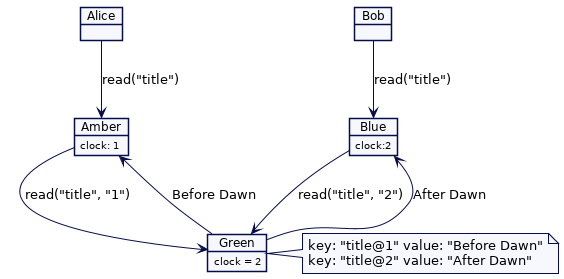
这违反了外部一致性。 如果 Alice 和 Bob 正在打电话沟通,Alice 会很困惑; Bob 会说title的最新值是After Dawn,而 Alice 的节点显示的title仍然是Before Dawn。
似乎节点 Blue 的值写入发生在”未来“。
如果以系统时间戳作为存储值的版本,就会引起这样的问题,因为系统时钟不是单调的。 来自不同服务器节点的时钟值不能也不应该进行比较。 当混合时钟用作版本值中的版本时,就能在单个服务器、以及因果相关的不同服务器上进行版本排序。 然而,混合时钟(或者任何基于 Lamport Clock 的时钟实现)都只能给出部分顺序(partial order)。 这就意味着不存在因果关系且分布在不同节点上值是无法排序的。 当使用时间戳读取集群不同节点值时,会引起问题:如果读取时钟滞后节点,那么节点可能无法返回值的最新版本。
解决方案
读取或写入值时,集群节点会陷入等待,直到集群中每个节点上的时间戳都高于请求时间戳。
如果时钟之间的间隔非常小,则写入请求可以等待,且不会造成大量开销。 例如,假设集群节点之间的最大时钟间隔为 10 ms。(这意味着,在任何时间点,集群中最慢的节点时钟落后 10ms。) 为了保证每个集群节点的时钟戳都大于t,处理写操作的节点需要在存储值之前等待 10ms。
一个具有版本的 KV 存储,每个更新操作都是一个追加操作,并使用时间戳作为版本号。 在上面提到的 Alice 和 Bob 例子中,写入title@2的操作将等待集群所有节点的时钟戳都处于 2。 这确保 Alice 始终会看到title的最新值,即使该节点时钟戳落后于其它节点。
考虑一个稍微不同的场景。 格林时间为2,Philip 正在将title更新为'After Dawn'。 Green 知道,此时写入可能有一台服务器的时间落后 1 个单位。因此,它必须在写入操作中等待 1 个单位时间。
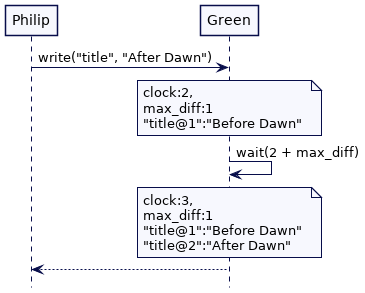
当 Philip 在更新title时,Bob 正在读取title,且读取请求由节点 Blue 处理。 节点 Blue 时间处于 2,因此它尝试读取时间戳为 2 的title。 此时节点 Green 尚未提供可用的值。 这意味着 Bob 读取到了小于时间戳 2 的值,即'Before Dawn'。
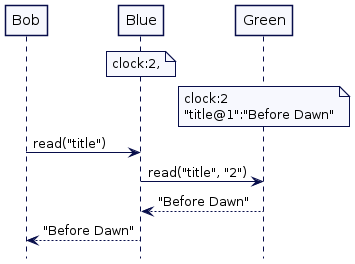
Alice 的读取请求由节点 Amber 处理。 节点 Amber 的时间戳为 1,因此它尝试读取时间戳 1 处的title。Alice 读取到值'Before Dawn'。

一旦 Philip 的写入完成(max_diff 的等待结束后),如果 Bob 现在发送新的读取请求,节点 Blue 将尝试根据其时间戳读取最新值(时间戳已到 3); 这将返回值'After Dawn'。
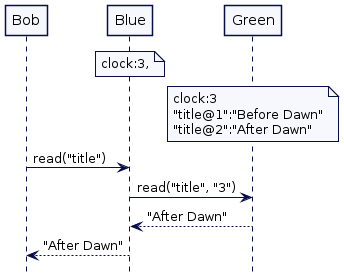
如果 Alice 发起一个新的读取请求,节点 Blue 将根据其时间戳(现在为 2)读取title最新值。因此,它也会返回值'After Dawn'。
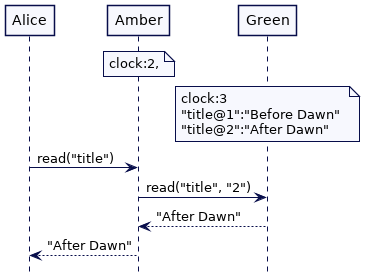
解决方案的主要问题是,使用普通可用的日期/时间硬件和操作系统 API 根本不可能获得集群节点之间的准确时间差。
因此 Google 有自己的专门日期时间 API,称为 True Time。 同样,亚马逊有 AWS 时间同步服务和一个名为 ClockBound的库。 然而,这些 API 是针对 Google 和 Amazon 的,其它企业和组织无法使用。
通常 KV 存储使用混合时钟来实现版本化。 虽然这也不可能获得时钟之间的确切差异,但可以根据历史观察选择合理的默认值。 观察发现,跨数据中心的服务器上的最大时钟偏差的通常为 200 到 500 ms。
KV 存储在存储值之前需要等待最大时钟偏差(可配置)。
class KVStore {
// ...
int maxOffset = 200;
NavigableMap<HybridClockKey, String> kv = new ConcurrentSkipListMap<>();
public void put(String key, String value) {
HybridTimestamp writeTimestamp = clock.now();
waitTillSlowestClockCatchesUp(writeTimestamp);
kv.put(new HybridClockKey(key, writeTimestamp), value);
}
private void waitTillSlowestClockCatchesUp(HybridTimestamp writeTimestamp) {
var waitUntilTimestamp = writeTimestamp.add(maxOffset, 0);
sleepUntil(waitUntilTimestamp);
}
private void sleepUntil(HybridTimestamp waitUntil) {
HybridTimestamp now = clock.now();
while (clock.now().before(waitUntil)) {
var waitTime = (waitUntil.getWallClockTime() - now.getWallClockTime()) ;
Uninterruptibles.sleepUninterruptibly(waitTime, TimeUnit.MILLISECONDS);
now = clock.now();
}
}
public String get(String key, HybridTimestamp readTimestamp) {
return kv.get(new HybridClockKey(key, readTimestamp));
}
}再次读取(Read Restart)
200 ms 的等待对于每个写入请求的耗时而言太长了。 这就是为什么 CockroachDB 或 YugabyteDB 这类数据库会改成在读取请求中检查。
当节点处理读取请求时,节点会检查在 readTimestamp 和 readTimestamp + maximum clock的时间间隔内是否有可用的数据版本。 如果可用版本的时间戳滞后,节点会要求客户端使用该版本重新读取。
class KVStore {
// ...
public void put(String key, String value) {
HybridTimestamp writeTimestamp = clock.now();
kv.put(new HybridClockKey(key, writeTimestamp), value);
}
public String get(String key, HybridTimestamp readTimestamp) {
checksIfVersionInUncertaintyInterval(key, readTimestamp);
return kv.floorEntry(new HybridClockKey(key, readTimestamp)).getValue();
}
private void checksIfVersionInUncertaintyInterval(String key, HybridTimestamp readTimestamp) {
HybridTimestamp uncertaintyLimit = readTimestamp.add(maxOffset, 0);
HybridClockKey versionedKey = kv.floorKey(new HybridClockKey(key, uncertaintyLimit));
if (versionedKey == null) {
return;
}
HybridTimestamp maxVersionBelowUncertainty = versionedKey.getVersion();
if (maxVersionBelowUncertainty.after(readTimestamp)) {
throw new ReadRestartException(readTimestamp, maxOffset, maxVersionBelowUncertainty);
}
;
}
}
class Client {
// ...
String read(String key) {
int attemptNo = 1;
int maxAttempts = 5;
while(attemptNo < maxAttempts) {
try {
HybridTimestamp now = clock.now();
return kvStore.get(key, now);
} catch (ReadRestartException e) {
logger.info(" Got read restart error " + e + "Attempt No. " + attemptNo);
Uninterruptibles.sleepUninterruptibly(e.getMaxOffset(), TimeUnit.MILLISECONDS);
attemptNo++;
}
}
throw new ReadTimeoutException("Unable to read after " + attemptNo + " attempts.");
}
}在上面的 Alice 和 Bob 例子中,如果在时间戳 2 处存在可用的title版本, 并且 Alice 发送时间戳为 1 的读取请求,则节点抛出 ReadRestartException,要求 Alice 以时间戳 2 为请求时间戳重新发起读取请求。
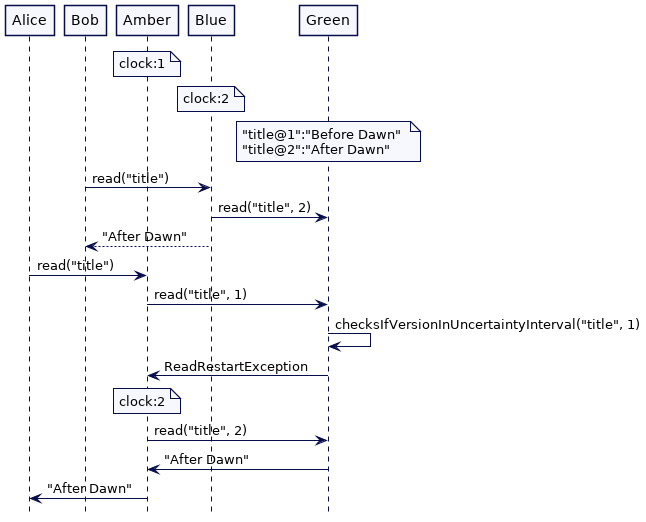
仅当在不确定时间区间内写入版本时,才会发生再次读取的问题。而写请求不需要等待。
但要记住的是,maximum clock偏差的配置项是一个假设,不能保证。 在某些情况下,不良的服务器的时钟偏差可能超过假定值,在这种情况下,一致性问题仍然存在。
使用时钟绑定 API(Using Clock Bound APIs)
谷歌和亚马逊等云提供商使用原子钟和 GPS 来实现时钟机制,以确保集群节点之间的时钟偏差保持在几毫秒以下。 正如我们刚才讨论的,谷歌拥有 True Time,AWS 拥有 AWS Time Sync Service 和 ClockBound。
为了确保正确实现读、写等待,集群节点有两个关键要求:
- 集群节点之间的时钟偏差保持在最低, Google 的 True Time 在大多数情况下将其保持在 1 ms 以下(最坏情况下为 7 ms);
- 时钟偏差能在日期/时间 API 中返回,确保使用者不需要猜测偏差值。
集群节点上的时钟机制能够计算日期时间值的误差范围。 本地系统时钟 API 能够返回时间偏差,给出时间偏差的下限和上限,从而保证实时值在此区间内。
public class ClockBound {
public final long earliest;
public final long latest;
public ClockBound(long earliest, long latest) {
this.earliest = earliest;
this.latest = latest;
}
public boolean before(long timestamp) {
return timestamp < earliest;
}
public boolean after(long timestamp) {
return timestamp > latest;
}
}正如本 AWS 博客中所述,每个节点的时钟无法为ClockErrorBound。 实时值在本地时钟时间(t)上下波动,将始终介于[t -ClockErrorBound, t + ClockErrorBound]之间。
调用日期时间 API 时,会返回时间误差范围:
public ClockBound now() {
return now;
}时钟绑定 API 保证了两个属性:
- 时钟范围应该在集群节点之间重叠;
- 对于两个时间值 t1 和 t2,如果 t1 小于 t2,则所有集群节点上的 clock_bound(t1).earliest 都小于 clock_bound(t2).latest
假设集群有三个节点:Green, Blue 和 Orange。 每个节点可能有不同的时钟错误偏差。 假设节点 Green 上的误差为 1,节点 Blue 为 2,节点 Orange 为 3。 在 time=4 时,跨集群节点的时钟绑定如下图所示:

在这种情况下,需要遵循两个规则来实现提交等待:
- 对于任何写入操作,应选择时钟范围的最新值作为时间戳。 这将确保它始终高于分配给先前写入操作的任何时间戳(考虑下面的第二条规则);
- 系统必须等到写入时间戳小于时钟范围的最早值,然后才能存储该值。
这是因为所有节点上的最早值保证低于时钟界限的最新值。 任何读取时钟且绑定最新值的请求都可以访问此写入操作的值,此外,在发生任何其他写入操作之前,该值是有序的。
class KVStore {
public void put(String key, String value) {
ClockBound now = boundedClock.now();
long writeTimestamp = now.latest;
addPending(writeTimestamp);
waitUntilTimeInPast(writeTimestamp);
kv.put(new VersionedKey(key, writeTimestamp), value);
removePending(writeTimestamp);
}
private void waitUntilTimeInPast(long writeTimestamp) {
ClockBound now = boundedClock.now();
while(now.earliest < writeTimestamp) {
Uninterruptibles.sleepUninterruptibly(now.earliest - writeTimestamp, TimeUnit.MILLISECONDS);
now = boundedClock.now();
}
}
private void removePending(long writeTimestamp) {
pendingWriteTimestamps.remove(writeTimestamp);
try {
lock.lock();
cond.signalAll();
} finally {
lock.unlock();
}
}
private void addPending(long writeTimestamp) {
pendingWriteTimestamps.add(writeTimestamp);
}
}TODO:翻译
如果我们回到上面的 Alice 和 Bob 示例,当 Philip 在服务器 Green 上写入“title”的值 - “After Dawn”时,Green 上的 put 操作将等待,直到所选的写入时间戳低于服务器 Green 的最早值。 时钟绑定。 这保证了每个其他集群节点都具有更高的时钟边界最新值的时间戳。 为了说明这一点,考虑这种情况。 绿色的误差范围为+-1。 因此,对于从时间 4 开始的 put 操作,当它存储值时,Green 将拾取时钟边界的最新值,即 5。然后它会等待,直到时钟边界的最早值大于 5。本质上, Green 在将值实际存储到键值存储中之前等待不确定性间隔。
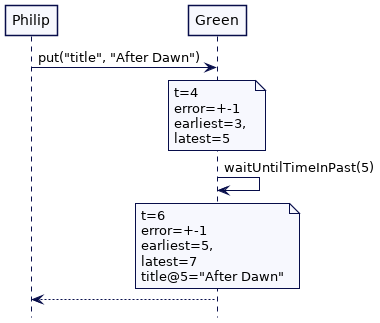
当该值在键值存储中可用时,每个集群节点上时钟边界的最新值都保证高于 5。 这意味着 Blue 处理的 Bob 请求以及 Amber 处理的 Alice 请求都可以保证获得最新的标题值。
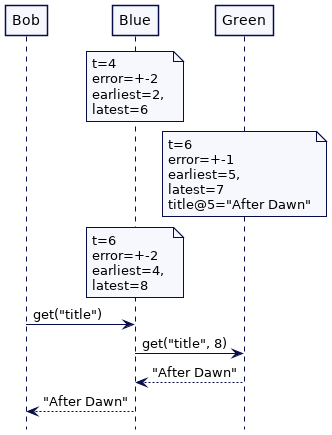
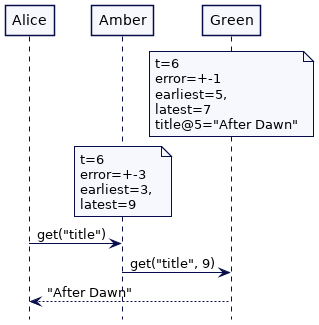
如果格林有“更宽”的时间范围,我们会得到相同的结果。 错误界限越大,等待的时间就越长。 如果 Green 的错误界限达到最大值,它将继续等待,然后再使值在键值存储中可用。 Amber 和 Blue 都无法获取该值,直到它们的最新时间值超过 7。当 Alice 在最晚时间 7 获取最新的 title 值时,将保证每个其他集群节点都能在它的时间获取该值。 最新时间值。
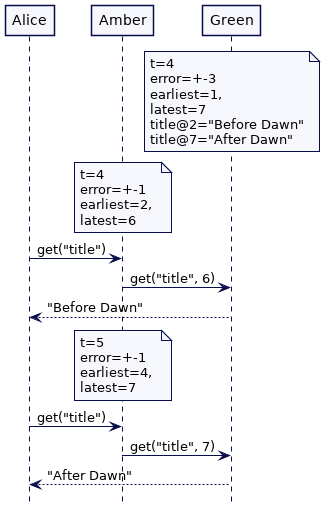
读等待(Read Wait)
当读取该值时,客户端将始终从其集群节点的时钟范围中选择最大值。
接收请求的集群节点需要确保一旦在特定请求时间戳返回响应,则在该时间戳或较低时间戳处没有写入任何值。
如果请求中的时间戳高于服务器上的时间戳,集群节点将等待时钟赶上,然后再返回响应。
然后,它将检查较低时间戳处是否有任何尚未存储的待处理写入请求。 如果有,则读取请求将暂停,直到请求完成。
然后,服务器将读取请求时间戳处的值并返回该值。 这确保了一旦在特定时间戳返回响应,就不会在较低时间戳写入任何值。 这种保证称为快照隔离
class KVStore {
final Lock lock = new ReentrantLock();
Queue<Long> pendingWriteTimestamps = new ArrayDeque<>();
final Condition cond = lock.newCondition();
public Optional<String> read(long readTimestamp) {
waitUntilTimeInPast(readTimestamp);
waitForPendingWrites(readTimestamp);
Optional<VersionedKey> max = kv.keySet().stream().max(Comparator.naturalOrder());
if(max.isPresent()) {
return Optional.of(kv.get(max.get()));
}
return Optional.empty();
}
private void waitForPendingWrites(long readTimestamp) {
try {
lock.lock();
while (pendingWriteTimestamps.stream().anyMatch(ts -> ts <= readTimestamp)) {
cond.awaitUninterruptibly();
}
} finally {
lock.unlock();
}
}
}考虑最后一个场景:Alice 的读取请求由服务器 Amber 处理,错误界限为 3。它选取读取标题的最新时间为 7。 同时,Philip 的写请求由 Green 处理(错误界限为+-1),它选取 5 来存储该值。 Alice 的读请求会等待,直到格林的最早时间超过 7 点,并且挂起的写请求。 然后它返回时间戳低于 7 的最新值。
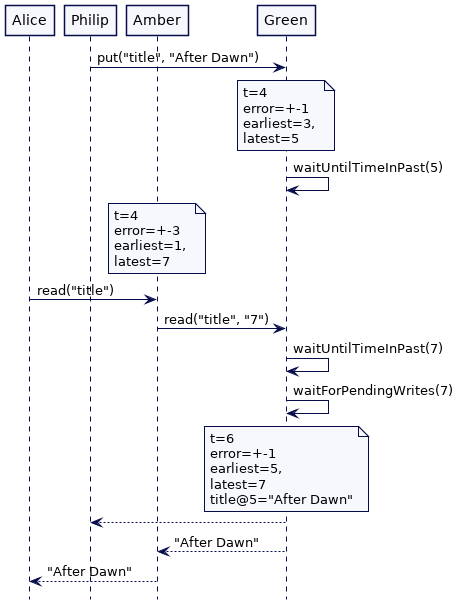
示例
- Google 的 TrueTime API 提供了时钟绑定。 Spanner 用它来实现 commit-wait。
- AWS Time Sync Service 可确保最小的时钟偏差。 可以使用 ClockBound API 来实现等待以对集群中的事件进行排序。
- CockroachDB 实现了 read start。 它还具有一个实验性选项,可以根据配置的最大时钟偏差值使用 commit-wait。
- YugabyteDB 根据配置的最大时钟误差值实现 read start。
